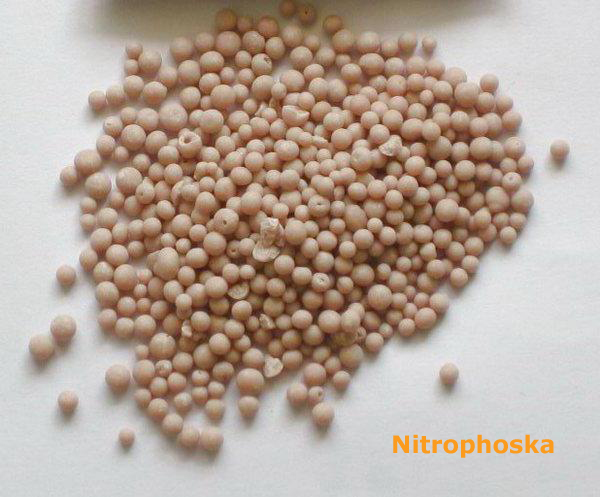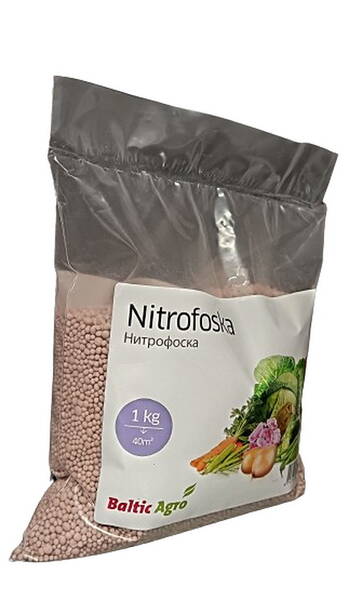Mineral fertilizer containing nutrients important for plants in a suitable proportion.
Suitable for almost all horticultural and field crops in spring and summer. Helps strengthen and grow plants.
1,0 kg = 40-50 m2.
How to apply: scatter the fertilizer around the plant, mix with the soil and then water the plant.
Application rates (g/m²):
Flowers and vegetables (cabbage, swede, beets) before sowing 70-100
Potatoes (before planting) 50-80
Open ground cucumbers 60-90
Beans, peas, beans 25-40
Carrots, onions 40-80
Fruit trees, berry bushes 15-40
Garden strawberry 9-25
Roses and other flower crops 45-60.
(1 teaspoon = approx. 8-10 g. 40 g = approximately a handful).

The main advantages of nitrophoska:
- versatility (with one preparation it is possible to treat both garden and vegetable, as well as garden and ornamental plants;
- environmental safety of top dressing (after seasonal events, the crop will not contain pesticides, nitrates and heavy metals);
- fast solubility in water;
- long time spent in the soil;
- balanced composition;
- active absorption by the plant root system (nitrogen "works" immediately, phosphorus - after a couple of weeks, which meets the needs of plants);
- low costs at an affordable price.
* Disadvantages are reduced to the consequences of improper use of the composition. If you follow the instructions for using nitrophoska fertilizer, then there will be no side effects.
If the number of treatments is abused or the recommended dosages are significantly exceeded, potassium and phosphorus will spoil the quality of the crop -
not only color and density will change, but also taste characteristics.
Features of the use of nitrophoska on different types of soil.
According to the instructions for use for seedlings, nitrophoska fertilizer should be used on a neutral soil type.
It is permissible to introduce substances into slightly acidic soils, and in other cases it will be necessary to select the correct ratio of substances in the composition.
Features of the use of agrochemicals depending on the type of soil.
* foliar treatment on sandstones is accompanied by rapid nitrogen leaching
(in order to retain useful substances, the application of nitrophoska is carried out simultaneously with spring digging, or dry granules are added to the hole during planting);
* on clay soils and peatlands, processing is carried out in the fall, when the land is being prepared for wintering;
* adult ornamental shrubs, regardless of the type of soil, are treated with watering (less often, useful substances are added to the hole closer to the root).
To get the maximum benefit, you should act strictly according to the instructions on the package.
More detailed instructions for using nitrophoska as a fertilizer.
* In spring, nitrophoska is used to prepare for upcoming planting. It is scattered over the entire area, the soil is dug up and watered abundantly.
The granules dissolve and improve the structure and composition of the soil. An average of 70 grams of the preparation is used per square meter of soil.
* The fertilizer is also used when planting seedlings and at the stage of sowing seeds, while the granules are poured onto the bottom of the holes or into the furrows of the beds and sprinkled with earth a little, so that nitrophoska does not burn the delicate roots of the plants.
* Perennial plants are fed with liquid solutions. The concentration depends on the needs of the crops.
* In the fall, after harvesting, fertilizing is carried out less often than in the spring. The preparation is added during digging.
In this case, the soil is enriched with microelements and restores its beneficial properties. Application rate: 80 kg per 100 m2.
* For flowers. Thanks to this nitrophoska top dressing, you can achieve abundant, long flowering. The rate of granule application during planting is 10 g per seedling.
Subsequently, the flowers are sprayed with an aqueous solution at a concentration of 0.04%.
* For vegetables. Tomatoes are fertilized 3 times: when planting seedlings, during flowering, and at the stage of ovary formation.
It is recommended to use a type of fertilizer with a high phosphorus content. An aqueous solution is prepared by diluting 1 teaspoon of the preparation in 1 liter of warm water.
* To obtain large garlic, 2 top dressings are enough: during plowing the soil and during planting in the hole.
* Fertilizing cucumbers with nitrophoska occurs in two stages:
1. When plowing the soil, granules are added at 30 g per 1 m2.
2. After the seeds have sprouted (or two weeks after planting the seedlings), feed the young shoots with a liquid solution at a rate of 2 tablespoons of the preparation per 10 liters of water.
* For berry bushes. Berry bushes and garden strawberries are fertilized with nitrophoska during planting. Application rate: 30 g per hole or bush.
Grape leaves are sprayed with a nutrient solution after sunset and then the plant is watered generously.
* For garden trees. Depending on the age and size of the tree, about 150-500 g of the preparation is used. Young trees are fed with nitrophoska during planting,
applying the fertilizer to the hole. Old trees are either treated with a liquid solution, or granules are embedded in the soil in the near-trunk circle, watering generously.
How is nitrophoska different from nitroammophoska?
Nitrophoska differs from nitroammophoska in the method of production, concentration and form of chemical compounds in the composition. It never contains magnesium.
In appearance, nitrophoska is easiest to distinguish by its grayish-white color, while nitroammophoska is pink.
Storage.
Compliance with simple rules for storing fertilizer will help preserve its beneficial properties for a long period:
- The humidity of the room should not rise above 60%, otherwise the fertilizers may become damp.
- The preparation should be stored in tight sealed bags to prevent it from mixing with other fertilizers, since the active substances easily react.
- Do not light a fire in the room where the fertilizers are stored!
- Children and animals should be denied access to the room.
Compatibility of nitrophoska with other types of fertilizers.
Compatible with: Ammonium sulfate, Ammophos, Calcium nitrate, Ammonium nitrate, Potassium nitrate.
Incompatible with: chicken manure, manure, Bordeaux mixture, ash, lime.
How to determine that plants need to be fed with nitrophoska?
You should not fertilize plants with nitrophoska without a good reason.
You can understand that crops lack nitrogen by external signs: slow growth, thin shoots, yellow leaves, small inflorescences.
Frequent diseases and low immunity indicate a lack of potassium.
Deformation of fruits and shoots, poor germination and purple-red color of leaves indicate a phosphorus deficiency.
Also, fertilization with nitrophoska is necessary if the soil is depleted.












